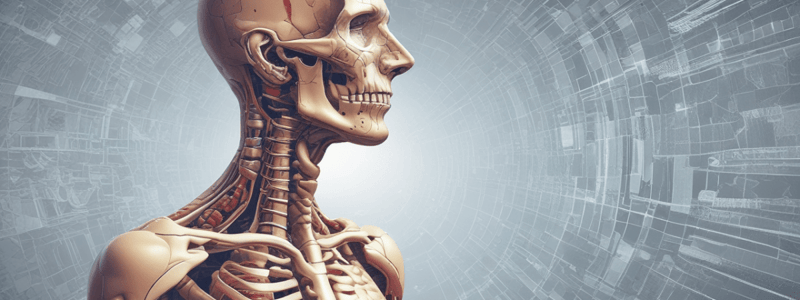Podcast
Questions and Answers
Which of the following is the first-line imaging modality for biliary pathology?
Which of the following is the first-line imaging modality for biliary pathology?
- MRI
- Ultrasound (correct)
- CT
- Plain Xray
What is the main indication for plain X-rays of the abdomen?
What is the main indication for plain X-rays of the abdomen?
- Detecting gallstones
- Suspected bowel obstruction (correct)
- Diagnosing appendicitis
- Evaluating liver cirrhosis
Which imaging modality is preferred for evaluating the inside lumen of the bowel?
Which imaging modality is preferred for evaluating the inside lumen of the bowel?
- Barium studies (correct)
- Plain Xray
- CT
- Ultrasound
When might MRCP be used instead of ultrasound for evaluating gallstones?
When might MRCP be used instead of ultrasound for evaluating gallstones?
What is a potential drawback of using barium studies for evaluating the bowel?
What is a potential drawback of using barium studies for evaluating the bowel?
Which of the following imaging modalities is commonly used to diagnose and monitor small bowel disease?
Which of the following imaging modalities is commonly used to diagnose and monitor small bowel disease?
Which imaging modality is considered the gold standard for evaluating diverticular disease?
Which imaging modality is considered the gold standard for evaluating diverticular disease?
What is the advantage of using ultrasound in children with acute abdomen compared to other modalities?
What is the advantage of using ultrasound in children with acute abdomen compared to other modalities?
Flashcards
First-line imaging for biliary pathology?
First-line imaging for biliary pathology?
Ultrasound is the initial imaging method for gallbladder and bile duct problems.
Main X-ray use in abdomen?
Main X-ray use in abdomen?
Plain abdominal X-rays are primarily used for suspected bowel blockages.
Best imaging for bowel lumen?
Best imaging for bowel lumen?
Barium studies are generally preferred to view the inside of the intestines.
MRCP use vs ultrasound for gallstones?
MRCP use vs ultrasound for gallstones?
Signup and view all the flashcards
Barium study bowel drawback?
Barium study bowel drawback?
Signup and view all the flashcards
Imaging for small bowel disease?
Imaging for small bowel disease?
Signup and view all the flashcards
Gold standard for diverticulitis?
Gold standard for diverticulitis?
Signup and view all the flashcards
Ultrasound advantage in children with acute abdomen?
Ultrasound advantage in children with acute abdomen?
Signup and view all the flashcards
Study Notes
Radiology Modalities in Gastrointestinal Radiology
- X-ray: used mainly for suspected bowel obstruction, poor soft tissue resolution
- Barium studies: can show the inside lumen of the bowel, used mainly for swallowing disorders
- Ultrasound: first line in biliary pathology, good for liver, spleen, and ascites, first line in children with acute abdomen, can diagnose and monitor small bowel disease
- CT: used extensively in the abdomen, can show normal anatomy, appendicitis, diverticular disease, liver cirrhosis with ascites, splenomegaly, and gallstones
- MRI: specifically used for Magnetic Resonance Cholangiopancreatogram (MRCP) to look for gallstones in the CBD if ultrasound can't see them
- Nuclear medicine: no specific details mentioned
Barium Studies
- Fluoroscopy: X-ray video
- Normal anatomy on Barium studies: no specific details mentioned
Conditions and Pathologies
- Achalasia: no specific details mentioned
- Hiatus hernia: no specific details mentioned
- Barium enema: used to look for polyps and inflammation of the colon, largely redundant now, replaced by CT colonography
- Small bowel obstruction vs Large bowel obstruction: no specific details mentioned
- Appendicitis: can be diagnosed using CT
- Diverticular disease: can be diagnosed using CT
- Liver cirrhosis with ascites: can be diagnosed using CT
- Splenomegaly: can be diagnosed using CT
- Gallstones: only 10% are calcified, ultrasound is better for diagnosis
Studying That Suits You
Use AI to generate personalized quizzes and flashcards to suit your learning preferences.
Related Documents
Description
Introduction to radiology modalities used in gastrointestinal imaging, including X-ray, Barium, Ultrasound, CT, MRI, and Nuclear medicine. Normal anatomy on Barium studies and fluoroscopy are also covered.



